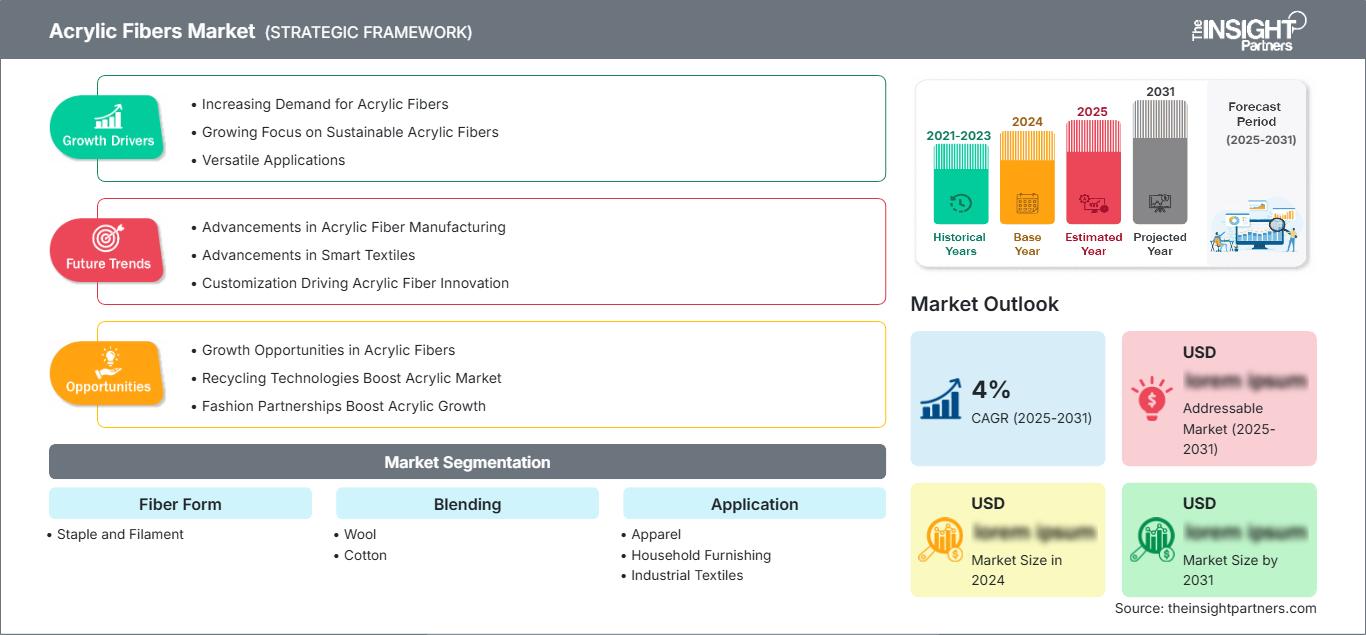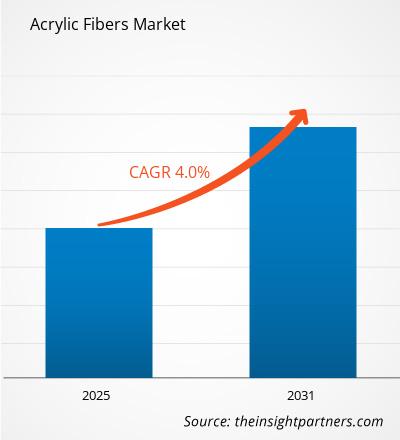Der Markt für Acrylfasern wird voraussichtlich zwischen 2025 und 2031 eine durchschnittliche jährliche Wachstumsrate (CAGR) von 4 % verzeichnen, wobei die Marktgröße von XX Millionen US-Dollar im Jahr 2024 auf XX Millionen US-Dollar im Jahr 2031 anwachsen wird.
Der Bericht zum Markt für Acrylfasern ist nach Faserform (Stapelfaser und Filamentfaser) segmentiert. Die Marktsegmentierung erfolgt nach Mischung (Wolle, Baumwolle und andere). Die Marktsegmentierung erfolgt nach Anwendung (Bekleidung, Haushaltswaren, Industrietextilien und andere). Die globale Analyse ist weiter auf regionaler Ebene und nach wichtigen Ländern aufgeschlüsselt. Der Umfang umfasst die Marktgröße und -prognose auf globaler, regionaler und Länderebene für alle wichtigen Marktsegmente. Der Bericht bietet den Wert in USD für die oben genannte Analyse, Segmente, Regionen und Länder. Der Bericht behandelt Markttrends sowie Marktdynamiken wie Treiber, Einschränkungen und wichtige Chancen. Der Bericht umfasst außerdem eine Branchenlandschaft und Wettbewerbsanalyse, die Marktkonzentration, Heatmap-Analysen, prominente Akteure und aktuelle Entwicklungen auf dem Markt umfasst.
Zweck des Berichts
Der Bericht „Acrylfasern-Markt“ von The Insight Partners beschreibt die aktuelle Landschaft und das zukünftige Wachstum sowie die wichtigsten treibenden Faktoren, Herausforderungen und Chancen. Dadurch erhält er Einblicke für verschiedene Geschäftsinteressenten, wie z. B.:
- Technologieanbieter/-hersteller: Um die sich entwickelnde Marktdynamik zu verstehen und die potenziellen Wachstumschancen zu erkennen, damit sie fundierte strategische Entscheidungen treffen können.
- Investoren: Um eine umfassende Trendanalyse hinsichtlich der Marktwachstumsrate, der finanziellen Marktprognosen und der Chancen entlang der Wertschöpfungskette durchzuführen.
- Regulierungsbehörden: Um Richtlinien und Überwachungsaktivitäten auf dem Markt zu regulieren, mit dem Ziel, Missbrauch zu minimieren, das Vertrauen der Investoren zu wahren und die Integrität und Stabilität des Marktes aufrechtzuerhalten.
Marktsegmentierung für Acrylfasern: Faserform
- Stapelfasern und Filamentfasern
Mischfasern
- Wolle
- Baumwolle
Anwendung
- Bekleidung
- Haushaltswaren
- Industrietextilien
Geografie
- Nordamerika
- Europa
- Asien-Pazifik
- Süd- und Mittelamerika
- Naher Osten und Afrika
Sie erhalten kostenlos Anpassungen an jedem Bericht, einschließlich Teilen dieses Berichts oder einer Analyse auf Länderebene, eines Excel-Datenpakets sowie tolle Angebote und Rabatte für Start-ups und Universitäten.
Markt für Acrylfasern: Strategische Einblicke

-
Holen Sie sich die wichtigsten Markttrends aus diesem Bericht.Dieses KOSTENLOSE Beispiel umfasst Datenanalysen, die von Markttrends bis hin zu Schätzungen und Prognosen reichen.
Wachstumstreiber für Acrylfasern
- Steigende Nachfrage nach Acrylfasern: Der Textilsektor ist möglicherweise der bedeutendste, da Acrylfasern Schäume mit geringer Dichte und geringem Gewicht sind, was sie zu perfekten Materialien für Innenräume, Kleidung und Teppiche macht. Leistungsstarke und ansprechend aussehende Stoffe erfreuen sich einer exponentiell steigenden Nachfrage, insbesondere in wachsenden, mittelschichtorientierten Volkswirtschaften, was wiederum eine verstärkte Verwendung von Acrylfasern bedeutet.
- Nachhaltige Acrylfasern rücken in den Fokus: Die Menschen suchen zunehmend nach umweltfreundlichen Materialien. Recyclingprozesse für Acrylfaserabfälle bieten dabei praktikable Alternativen zu den häufiger verwendeten Fasern. Immer mehr Hersteller suchen heute nach Verfahren zur Herstellung solcher Fasern und folgen damit dem weltweiten Trend zur Produktion nachhaltiger und umweltfreundlicher Materialien.
- Vielseitige Anwendungen: Acrylfasern werden nicht nur in Textilien, sondern auch in einer Reihe von Produkten wie Autoinnenausstattungen, Möbeln, Teppichen und industriellen Textilprodukten eingesetzt. Sie eignen sich aufgrund ihrer Feuchtigkeits- und UV-Beständigkeit gut für den Außenbereich. Diese Vielfalt fördert das Wachstum in zahlreichen Sektoren und fördert so das Wachstum des Marktes für Acrylfasern.
Zukünftige Trends im Markt für Acrylfasern
- Fortschritte in der Acrylfaserherstellung: Neue Herstellungsverfahren dürften die Qualität von Acrylfasern verbessern und deren Preise senken. Kostengünstige Polymerisations- und Spinntechniken ermöglichen die Herstellung von Fasern mit hervorragenden Eigenschaften wie Haltbarkeit und Farbechtheit. Marken und Unternehmen investieren in Forschung und Entwicklung.
- Fortschritte bei intelligenten Textilien: Moderne Technologie hat Einzug in die Textilindustrie gehalten, ein Trend, der insbesondere darin besteht, dass intelligente Textilien in vielen Bereichen wie Sportbekleidung, Gesundheit und anderen tragbaren Technologien eingesetzt werden. Es besteht ein Interesse daran, Acrylfaser-Verbundwerkstoffe zum Einbetten von Sensoren und Elektronik für solche fortschrittlichen Anwendungen zu verwenden. Dies dürfte den Einsatz von Acrylfasern in der technologieorientierten Modebranche fördern.
- Individualisierung treibt Innovationen bei Acrylfasern voran: Mit dem wachsenden Wunsch der Verbraucher nach personalisierten Produkten verzehnfacht sich die Zahl der Textilien, die von Verbrauchern nach Bedarf verwendet werden können. Gefärbt, veredelt und gewebt ermöglichen Acrylfasern den Herstellern, unterschiedliche Produkte anzubieten, die den Erwartungen unterschiedlicher Verbraucher gerecht werden. Dieser Trend zur Individualisierung kann die Entwicklung neuer Produktionstechnologien für Acrylfasern fördern, da die Marken nach neuen Formen und Funktionen streben.
Marktchancen für Acrylfasern
- Wachstumschancen bei Acrylfasern: Der Markt für Acrylfasern steht vor Wachstumsaussichten, insbesondere in den Entwicklungsregionen Asien-Pazifik, Lateinamerika und Afrika. Die zunehmende Urbanisierung und das steigende Einkommen der Mittelschicht in diesen Regionen erfordern mehr Textilien und Bekleidung. Hersteller können diesem Trend begegnen, indem sie in lokale Produktionsanlagen investieren oder strategische Partnerschaften eingehen, um diese schnell wachsenden Volkswirtschaften zu bedienen.
- Recyclingtechnologien beflügeln den Acrylmarkt: Die Herstellung recycelter Acrylfasern verspricht eine Geschäftsmöglichkeit. Hersteller konzentrieren sich auf die Entwicklung von Technologien zur Verarbeitung von Acrylabfällen aus Konsum- und Industrieabfällen. Auf diese Weise können die Unternehmen ihre Produkte auch effektiver vermarkten, da die angebotenen Lösungen Verbraucher mit einer grünen Einstellung zur Umwelt ansprechen.
- Modepartnerschaften fördern Acrylwachstum: Die kreativen Ideen, die aus den Verbindungen zwischen Acrylfaserherstellern und der Modebranche entstehen, bieten zusätzliche Wachstumschancen. Hersteller können dann mit Designern zusammenarbeiten und spezifische Acrylobjekte entwerfen, die auf einen bestimmten Markt oder eine bestimmte Mode zugeschnitten sind. Dies kann auch dazu beitragen, das Markenimage zu stärken und durch das erzielte Wachstum den Umsatz zu steigern.
Regionale Einblicke in den Markt für Acrylfasern
Die Analysten von The Insight Partners haben die regionalen Trends und Faktoren, die den Acrylfasermarkt im Prognosezeitraum beeinflussen, ausführlich erläutert. In diesem Abschnitt werden auch die Marktsegmente und die geografische Lage in Nordamerika, Europa, dem asiatisch-pazifischen Raum, dem Nahen Osten und Afrika sowie Süd- und Mittelamerika erörtert.
Umfang des Marktberichts zu Acrylfasern
| Berichtsattribut | Einzelheiten |
|---|---|
| Marktgröße in 2024 | US$ XX million |
| Marktgröße nach 2031 | US$ XX Million |
| Globale CAGR (2025 - 2031) | 4% |
| Historische Daten | 2021-2023 |
| Prognosezeitraum | 2025-2031 |
| Abgedeckte Segmente |
By Faserform
|
| Abgedeckte Regionen und Länder |
Nordamerika
|
| Marktführer und wichtige Unternehmensprofile |
|
Dichte der Marktteilnehmer für Acrylfasern: Verständnis ihrer Auswirkungen auf die Geschäftsdynamik
Der Markt für Acrylfasern wächst rasant. Die steigende Nachfrage der Endverbraucher ist auf Faktoren wie veränderte Verbraucherpräferenzen, technologische Fortschritte und ein stärkeres Bewusstsein für die Produktvorteile zurückzuführen. Mit der steigenden Nachfrage erweitern Unternehmen ihr Angebot, entwickeln Innovationen, um den Bedürfnissen der Verbraucher gerecht zu werden, und nutzen neue Trends, was das Marktwachstum weiter ankurbelt.

- Holen Sie sich die Markt für Acrylfasern Übersicht der wichtigsten Akteure
Wichtige Verkaufsargumente
- Umfassende Abdeckung: Der Bericht analysiert umfassend Produkte, Dienstleistungen, Typen und Endnutzer des Acrylfasermarktes und bietet einen ganzheitlichen Überblick.
- Expertenanalyse: Der Bericht basiert auf dem umfassenden Verständnis von Branchenexperten und Analysten.
- Aktuelle Informationen: Der Bericht gewährleistet Geschäftsrelevanz durch die Berichterstattung über aktuelle Informationen und Datentrends.
- Anpassungsoptionen: Dieser Bericht kann an spezifische Kundenanforderungen angepasst werden und passt sich optimal an die Geschäftsstrategien an.
Der Forschungsbericht zum Acrylfasermarkt kann daher dazu beitragen, die Branchensituation und die Wachstumsaussichten zu entschlüsseln und zu verstehen. Obwohl es einige berechtigte Bedenken geben kann, überwiegen die Vorteile dieses Berichts tendenziell die Nachteile.
- Historische Analyse (2 Jahre), Basisjahr, Prognose (7 Jahre) mit CAGR
- PEST- und SWOT-Analyse
- Marktgröße Wert/Volumen – Global, Regional, Land
- Branchen- und Wettbewerbslandschaft
- Excel-Datensatz
Aktuelle Berichte
Verwandte Berichte
Erfahrungsberichte
Grund zum Kauf
- Fundierte Entscheidungsfindung
- Marktdynamik verstehen
- Wettbewerbsanalyse
- Kundeneinblicke
- Marktprognosen
- Risikominimierung
- Strategische Planung
- Investitionsbegründung
- Identifizierung neuer Märkte
- Verbesserung von Marketingstrategien
- Steigerung der Betriebseffizienz
- Anpassung an regulatorische Trends






















 Kostenlose Probe anfordern für - Markt für Acrylfasern
Kostenlose Probe anfordern für - Markt für Acrylfasern